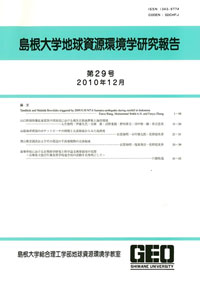島根大学総合理工学部地球資源環境学教室
ISSN:1343-9774

ダウンロード数 : ? 件
この文献の参照には次のURLをご利用ください : https://ir.lib.shimane-u.ac.jp/6108
島根大学地球資源環境学研究報告 21
2002-12-27 発行
堆積物の元素組成から見た球磨川,川辺川流域の環境評価
Evaluation of sedimentary environments from compositions of sediments from the Kuma and Kawabe Rivers,Kyushu,Japan
道前 香緒里
ファイル
内容記述(抄録等)
Sedimentary environments of the fluvial systems of the Kuma and Kawabe Rivers were evaluated using geochemical parameters which are sensitive to redox conditions and accumulation oforganic matter.Zn-Fe_2O_3*(total Fe),As-P_2O_5,and Br-Zn discrimination diagrams were applied to disclose variations in geochemical compositions of dam lake bottom deposits(from the Ichifusa,Arase and Youhai dams and dyke),and fluvial and tidal flat sediments of the Yatushiro Sea.
The dam lake sediments are characterized by greater Zn concentrations relative to Fe_2O_3*.However,samples from Ichifusa dam show compositions similar to those of common lagoon sediments,probably due to variation in the sedimentary sequence of the lake deposits.This variation resulted from changing water levels in the dam.These changes are probably seasonal.Arsenic concentrations in Ichifusa dam are greater than in the other sediments,suggesting As adsorption on buried organic matter such as woods,branches and leafs of trees transported by debris flows.The concentrations of Br and Zn show good correlation in the sediments of the Arase dam,suggesting the abundance of these elements are related to accumulation of algae and preservation in the sediments under reducing conditions.
REE patterns and Th/Sc ratios were utilized to examine the provenance of the fluvial sediments and to examine modes of mixing of potential source materials.The results indicate that the sediment of the Ichifusa dam have evolved source and
that of the Kawabe River has similar one.The compositions of the Youhai dyke sediments in the lower part of the Kuma River can be modeled by mixing Ichifusa dam sediments(upper Kums River)and Kawabe River sediments in a mixing ratio of 60 to 40%.Composition of Yatsushiro Sea sediments at the mouth of the Kuma River is characterized by lower Eu/Eu* values.This suggests more evolved source material in that area,derived from the wider region surrunding the Yatsushiro Sea, such as Paleogene-Cretaceous sediments of the Amakusa Islands.The variation of composition in the Yatushiro Sea sediments from the representative Kuma River may indicate decreased supply of detritus from the Kuma River systems.
The dam lake sediments are characterized by greater Zn concentrations relative to Fe_2O_3*.However,samples from Ichifusa dam show compositions similar to those of common lagoon sediments,probably due to variation in the sedimentary sequence of the lake deposits.This variation resulted from changing water levels in the dam.These changes are probably seasonal.Arsenic concentrations in Ichifusa dam are greater than in the other sediments,suggesting As adsorption on buried organic matter such as woods,branches and leafs of trees transported by debris flows.The concentrations of Br and Zn show good correlation in the sediments of the Arase dam,suggesting the abundance of these elements are related to accumulation of algae and preservation in the sediments under reducing conditions.
REE patterns and Th/Sc ratios were utilized to examine the provenance of the fluvial sediments and to examine modes of mixing of potential source materials.The results indicate that the sediment of the Ichifusa dam have evolved source and
that of the Kawabe River has similar one.The compositions of the Youhai dyke sediments in the lower part of the Kuma River can be modeled by mixing Ichifusa dam sediments(upper Kums River)and Kawabe River sediments in a mixing ratio of 60 to 40%.Composition of Yatsushiro Sea sediments at the mouth of the Kuma River is characterized by lower Eu/Eu* values.This suggests more evolved source material in that area,derived from the wider region surrunding the Yatsushiro Sea, such as Paleogene-Cretaceous sediments of the Amakusa Islands.The variation of composition in the Yatushiro Sea sediments from the representative Kuma River may indicate decreased supply of detritus from the Kuma River systems.
Other Article
